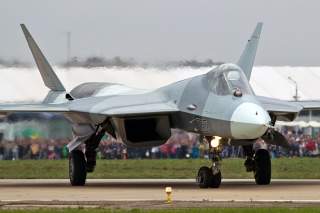China Thinks Russia's New Stealth Fighter 'Trashes' the F-35
Thanks to some unique technology.
The Su-57 completely 'trashes' the latest American fighters like the F-35—at least, according to Chinese media.
Earlier this month, Chinese defense news outlet Mil.news.sina published an analytical piece on the state of Russia’s arsenal. The article looked to the Su-57, Russia’s upcoming fifth generation stealth fighter, as a case study in the failures and successes of Russia’s ambitious, decades-long campaign to modernize its armed forces.
Whereas other fifth-generation fighters—most prominently, the US F-35—are strategic weapons, the author argues that the Su-57 was designed for an entirely different purpose that makes sense within the broader context of Russian military doctrine: “The Russians have a very simple idea. Nuclear weapons will defend Russia against the aggression of great powers. Jet fighters, military vessels, and other tactical weapons will guarantee Russia’s victory in small, local conflicts.”
This first appeared earlier in 2019.
The publication then turns to an in-depth treatment of what they consider to be the Su-57’s trump card against American military hardware: its “stealth-killing” radio-photonic radar. Mil.news lavishes the Su-57’s radar system with an impressive features list, including a “theoretical” maximum detection distance of 500 kilometers, imaging resolution and bandwith dozens of times greater than the “traditional” radar, and the ability to seamlessly switch between multiple frequencies without compromising performance. The article’s baseline standard for “traditional” radar specifications remains unclear.
The latter assertion figures prominently into their conclusion that the Su-57’s radar “trashes” even the “powerful electronic jammers” found on the F-35; whereas Russia was previously “helpless” against US jamming, “the new radar will directly ignore electronic interference.” Considering that the F-35 is supposed to make up what it lacks in the Su-57’s raw speed, maneuverability, and power with superior avionics and ECM (electronic counter measures) tools, Mil.news’ analysis seems to strip the F-35 of its primary advantage over its Russian counterpart.
Naturally, Russian media seized on this part of the article. Russian defense commentators always welcome positive appraisals of the Su-57, but much more so in the present arms trade context between Moscow and Beijing. This article comes at a time when Rosoboronexport—the Kremlin’s state arms export agency—is actively trying to sell China the Su-57 on the heels of a successful 2015 export contract for the Su-35 fighter. But as previously highlighted by The National Interest , there are difficult questions to be asked about the feasibility of a Su-57 export deal in light of China’s commitment to its own J-20 stealth fighter program.
It should be noted that the full capabilities of the Su-57’s radar system have yet to be revealed. The Chinese piece concedes as much, framing its potential less as a given and more as a possibility that’s contingent on certain developmental criteria: “If the Russians can seize this opportunity, the Su -7 fighter may really turn defeat into victory!.” Moreover, the full article begins by highlighting the considerable technical and financial challenges encountered by the Su-57 program. Among other problems, it voices the popular concern that the Su-57 is being cannibalized by the success of the comparable but significantly cheaper Su-35.
Nonetheless, the piece joins a deluge of recent Chinese defense commentary praising, or at least favorably hedging their bets, on the Su-57.
Image: Creative Commons.

